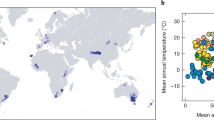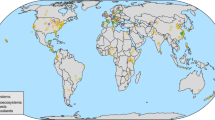Abstract
Global environmental changes are hypothesized to affect herbivores indirectly via changes in plant defenses, and many studies have been conducted to explore effects of environmental change on plant chemistry and herbivory. We quantitatively synthesized data from these studies to produce generalities about the effects of a broad array of environmental changes on herbivores. Since conversion of natural habitat to agriculture has been one of the most profound environmental changes over the past century, the effects of global change variables on plant defense were also compared between natural and agricultural systems. We found evidence that increasing CO2, light availability, and nutrients all consistently increase herbivory, particularly by generalists. No significant differences in chemistry and herbivory response variables were found between natural and managed systems. Overall, these results are consistent with recent predictions of a disruption of natural trophic interactions with global change.


Similar content being viewed by others
References
Agrell J, McDonald EP, Lindroth RL (2000) Effects of CO2 and light on tree phytochemistry and insect performance. Oikos 88:259–272
Agrell J, Anderson P, Oleszek W et al (2004) Combined effects of elevated CO2 and herbivore damage on alfalfa and cotton. J Chem Ecol 30:2309–2324
Applebaum SW, Birk Y (1979) Saponins. In: Rosenthal GA, Janzen DH (eds) Herbivores: their interaction with secondary plant metabolites. Academic Press, New York, pp 539–566
Arany AM, de Jong TJ, Kim HK et al (2008) Glucosinolates and other metabolites in the leaves of Arabidopsis thaliana from natural populations and their effects on a generalist and a specialist herbivore. Chemoecology 18:65–71
Bale JS, Masters GJ, Hodkinson ID et al (2002) Herbivory in global climate change research: direct effects of rising temperature on insect herbivores. Glob Change Biol 8:1–16
Behmer ST, Lloyd CM, Raubenheimer D et al (2005) Metal hyperaccumulation in plants: mechanisms of defence against insect herbivores. Funct Ecol 19:55–66
Bernays EA, Chapman RF (1994) Host-plant selection by phytophagous insects. Chapman & Hall, New York
Bezemer TM, Jones TH (1998) Plant-insect herbivore interactions in elevated atmospheric CO2: quantitative analyses and guild effects. Oikos 82:212–222
Bidart-Bouzat MG, Imeh-Nathaniel A (2008) Global change effects on plant chemical defenses against insect herbivores. J Integr Plant Biol 50:1339–1354
Bryant JP, Chapin FS III, Klein DR (1983) Carbon/nutrient balance of boreal plants in relation to vertebrate herbivory. Oikos 40:357–368
Cannon RJC (1998) The implications of predicted climate change for insect pests in the UK, with emphasis on non-indigenous species. Glob Change Biol 4:785–796
Coley PD (1983) Herbivory and defensive characteristics of tree species in a lowland tropical forest. Ecol Monogr 53:209–229
Coley PD, Bryant JP, Chapin FS (1985) Resource availability and plant antiherbivore defense. Science 230:895–899
Cooper H, Hedges LV, Valentine JC (2009) The handbook of research synthesis and Meta Analysis, Second Edition edn. Russell Sage Foundation, New York
Cornell HV, Hawkins BA (2003) Herbivore responses to plant secondary compounds: a test of phytochemical coevolution theory. Am Nat 161:507–522
Dyer LA, Coley PD (2001) Latitudinal gradients in tri-trophic interactions. In: Twscharntke T, Hawkins BA (eds) Multitrophic level interactions. Cambrige University Press, Cambrige, pp 67–88
Dyer LA, Dodson CD, Stireman JO III et al (2003) Synergistic effects of three Piper amides on generalist and specialist herbivores. J Chem Ecol 29:2499–2514
Easterling DR, Meehl GA, Parmesan C et al (2000) Climate extremes: observations, modeling, and impacts. Science 289:2068–2074
Ehrlich PR, Raven PH (1964) Butterflies and plants: a study in coevolution. Evolution 18:586–608
Feeny P (1976) Plant apparency and chemical defense. In: Wallace J, Mansell R (eds) Biochemical interactions between plants and insects. Recent advances in phytochemistry, vol 10. Plenum Press, New York, pp 1–40
Fincher RM (2007) Patterns of plant defense in the genus Piper. Dissertation, Tulane University
Galloway JN, Townsend AR, Erisman JW et al (2008) Transformation of the nitrogen cycle: recent trends, questions, and potential solutions. Science 320:889–892
Goverde M, Bazin A, Shykoff JA, Erhardt A (1999) Influence of leaf chemistry of Lotus corniculatus (Fabaceae) on larval development of Polyommatus icarus (Lepidoptera, Lycaenidae): effects of elevated CO2 and plant genotype. Funct Ecol 13:801–810
Gurevitch J, Hedges LV (2001) Meta analysis: combining the results of independent experiments. In: Scheiner SM, Gurevitch J (eds) Design and analysis of ecological experiments. Oxford University Press, New York, pp 347–369
Hamilton JG, Zangerl AR, Berenbaum MR et al (2004) Insect herbivory in an intact forest understory under experimental CO2 enrichment. Oecologia 138:566–573
Hamilton JG, Dermondy O, Aldea M et al (2005) Anthropogenic changes in tropospheric composition increase susceptibility of soybean to insect herbivory. Environ Entomol 34:479–485
Herms DA, Mattson WJ (1992) The dilemma of plants: to grow or defend. Q Rev Biol 67:283–335
Holton MK, Lindroth RL, Nordheim EV (2003) Foliar quality influences tree-herbivore-parasitoid interactions: effects of elevated CO2, O3, and plant genotype. Oecologia 137:233–244
Horner JD, Abrahamson WG (1999) Influence of plant genotype and early-season water deficits on oviposition preference and offspring performance in Eurosta solidaginis (Diptera: Tephritidae). Am Midl Nat 142:162–172
Hunter MA, Forkner RE (1999) Hurricane damage influences foliar polyphenolics and subsequent herbivory on surviving trees. Ecology 80:2676–2682
Intergovernmental Panel on Climate Change (2007) Climate change 2007: synthesis report. Cambridge University Press, Cambridge, United Kingdom
Jaenike J (1990) Host specialization in phytophagous insects. Annu Rev Ecol Evol S 21:243–273
Koricheva J, Larsson S, Haukioja E, Keinanen M (1998) Regulation of woody plant secondary metabolism by resource availability: hypothesis testing by means of meta-analysis. Oikos 83:212–226
Koricheva J, Nykanen H, Gianoli E (2004) Meta-analysis of trade-offs among plant antiherbivore defenses: are plants jacks-of-all-trades, masters of all? Am Nat 163:E64–E75
Lindroth RL, Kinney KK, Platz CL (1993) Responses of deciduous trees to elevated atmospheric CO2: productivity, phytochemistry, and insect performance. Ecology 74:763–777
Lindroth RL, Roth S, Kruger EL et al (1997) CO2-mediated changes in aspen chemistry: effect on gypsy moth perfomance and suscetibility to virsus. Glob Change Biol 3:279–289
Logan JA, Regniere J, Powell JA (2003) Assessing the impacts of global warming on forest pest dynamics. Front Ecol Environ 1:130–137
McDonald EP, Agrell J, Lindroth RL (1999) CO2 and light effects on deciduous trees: growth, foliar chemistry, and insect performance. Oecologia 119:389–399
McKenzie RL, Aucamp PJ, Bais AF et al (2007) Changes in biologically-active ultraviolet radiation reaching the Earth’s surface. Photochem Photobio S 6:218–231
Nykanen H, Koricheva J (2004) Damage-induced changes in wood plants and their effects on insect herbivore performance: a meta-analysis. Oikos 104:247–268
Prudic KL, Oliver JC, Bowers MD (2005) Soil nutrient effects on oviposition preference, larval performance, and chemical defense of a specialist insect herbivore. Oecologia 143:578–587
Reddy GVP, Tossavainen P, Nerg A, Holopainen JK (2004) Elevated atmospheric CO2 affects the chemical quality of Brassica plants and the growth rate of the specialist, Plutella xylostella, but not the generalist, Spodoptera littoralis. Ag Food Chem 52:4185–4191
Rendina-Gobioff G, Kromrey JD (2006) PUB_BIAS: A SAS Macro for detecting publication bias in meta-analysis. http://analytics.ncsu.edu/sesug/2006/PO04_06.PDF
Rhoades DF, Cates RG (1976) Toward a general theory of plant antiherbivore chemistry. In: Wallace J, Mansell R (eds) Biochemical interactions between plants and insects. Recent advances in phytochemistry, vol 10. Plenum Press, New York, pp 168–213
Root RB (1973) Organization of a plant-arthropod association in simple and diverse habitats: the fauna of collards (Brassica oleracea). Ecol Monogr 43:95–124
Rosenberg MS (2005) The file-drawer problem revisited: a general weighted method for calculating fail-safe numbers in meta-analysis. Evolution 59:464–468
Singer MS, Rodrigues D, Stireman JO III, Carriere Y (2004) Roles of food quality and enemy-free space in host use by a generalist insect herbivore. Ecology 85:2747–2753
Smilanich AM (2008) Variation in plant chemical defense and the physiological response of specialist and generalist herbivores. Dissertation, Tulane University
Stiling P, Cornelissen T (2007) How does elevated carbon dioxide (CO2) affect plant-herbivore interactions? A field experiment and meta-analysis of CO2-mediated changes on plant chemistry and herbivore performance. Glob Change Biol 13:1823–1842
Stiling P, Moon DC, Hunter MD et al (2003) Elevated CO2 lowers relative and absolute herbivore density across all species of a scrub-oak forest. Oecologia 134:82–87
Stireman JO III, Dyer LA, Janzen DH et al (2005) Climatic unpredictability and parasitism of caterpillars: implications of global warming. P Natl Acad Sci USA 102:17384–17387
Thomson LJ, Macfadyen S, Hoffmann AA (2010) Predicting the effects of climate change on natural enemies of agricultural pests. Biol Control 52:296–306
Tylianakis JM, Didham RK, Bascompte J, Wardle DA (2008) Global change and species interactions in terrestrial ecosystems. Ecol Lett 11:1351–1363
van Dam NM, Hadwich K, Baldwin IT (2000) Induced responses in Nicotiana attenuata affect behavior and growth of the specialist herbivore Manduca sexta. Oecologia 122:371–379
Vitousek PM, Aber JD, Howarth RW et al (1997) Human alteration of the global nitrogen cycle: sources and consequences. Ecol Appl 7:737–750
Whittaker JB (1999) Impacts and responses at population level of herbivorous insects to elevated CO2. Eur J Entomol 96:149–156
Zvereva EL, Kozlov MV (2006) Consequences of simultaneous elevation of carbon dioxide and temperature for plant-herbivore interactions: a metaanalysis. Glob Change Biol 12:27–41
Acknowledgments
We would like to thank Mark Fox, Angela Smilanich, Malia Fincher, and Karen Holl for important comments on the manuscript. We would also like to thank Dr. Rosenberg for his assistance with the use of his fail-safe number calculator.
Author information
Authors and Affiliations
Corresponding author
Additional information
Handling Editor: Gimme Walter.
Electronic supplementary material
Below is the link to the electronic supplementary material.
Rights and permissions
About this article
Cite this article
Massad, T.J., Dyer, L.A. A meta-analysis of the effects of global environmental change on plant-herbivore interactions. Arthropod-Plant Interactions 4, 181–188 (2010). https://doi.org/10.1007/s11829-010-9102-7
Received:
Accepted:
Published:
Issue Date:
DOI: https://doi.org/10.1007/s11829-010-9102-7




